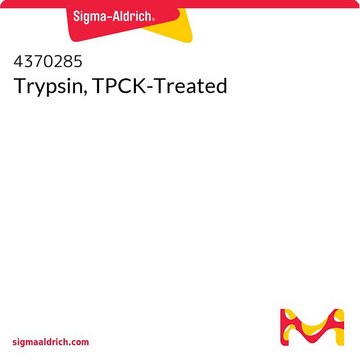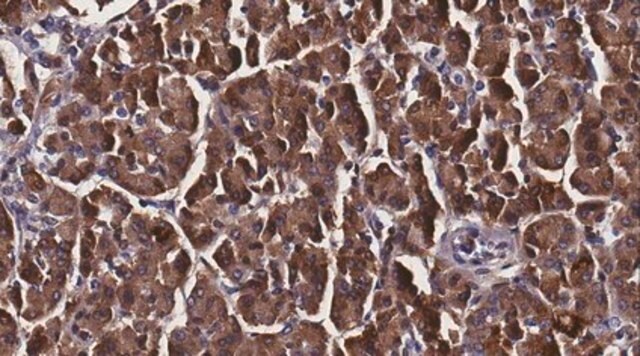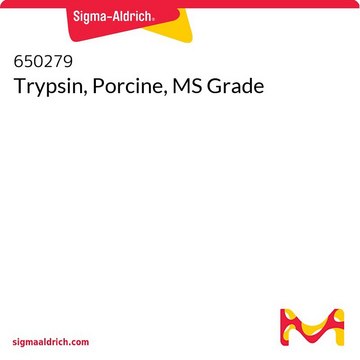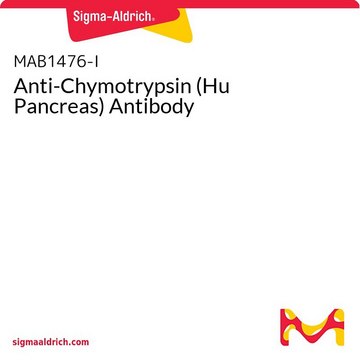MAB1482
Anti-Trypsin Antibody, human pancreas
ascites fluid, Chemicon®
Sign Into View Organizational & Contract Pricing
All Photos(1)
About This Item
UNSPSC Code:
12352203
eCl@ss:
32160702
NACRES:
NA.41
Recommended Products
biological source
mouse
antibody form
ascites fluid
antibody product type
primary antibodies
clone
monoclonal
species reactivity
human
manufacturer/tradename
Chemicon®
technique(s)
ELISA: suitable
isotype
IgG2b
NCBI accession no.
UniProt accession no.
shipped in
dry ice
target post-translational modification
unmodified
Gene Information
human ... PRSS1(5644)
Specificity
Recognizes trypsin -1
Immunogen
Epitope: human pancreas
Purified human pancreatic trypsin.
Application
Anti-Trypsin Antibody, human pancreas detects level of Trypsin & has been published & validated for use in ELISA.
Immunohistochestry/IH(P): {Solakidi, et al. 2003} 1:100-1:500; formalin fixed, paraffin embedded human tissues; 5μm serial sections; blocking solution 0.5% serum in PBS; overnight incubations; enzymatic detection.
ELISA at 1:25,600.
ELISA at 1:25,600.
Research Category
Metabolism
Metabolism
Research Sub Category
Enzymes & Biochemistry
Enzymes & Biochemistry
Storage and Stability
Maintain at -20°C in convenient aliquots for up to 12 months. Avoid repeated freeze/thaw cycles.
Legal Information
CHEMICON is a registered trademark of Merck KGaA, Darmstadt, Germany
Disclaimer
Unless otherwise stated in our catalog or other company documentation accompanying the product(s), our products are intended for research use only and are not to be used for any other purpose, which includes but is not limited to, unauthorized commercial uses, in vitro diagnostic uses, ex vivo or in vivo therapeutic uses or any type of consumption or application to humans or animals.
Not finding the right product?
Try our Product Selector Tool.
Storage Class Code
10 - Combustible liquids
WGK
WGK 1
Flash Point(F)
Not applicable
Flash Point(C)
Not applicable
Certificates of Analysis (COA)
Search for Certificates of Analysis (COA) by entering the products Lot/Batch Number. Lot and Batch Numbers can be found on a product’s label following the words ‘Lot’ or ‘Batch’.
Already Own This Product?
Find documentation for the products that you have recently purchased in the Document Library.
Patrycja J Puiman et al.
Pediatric research, 69(3), 217-223 (2011-03-05)
Paneth cell dysfunction has been suggested in necrotizing enterocolitis (NEC). The aim of this study was to i) study Paneth cell presence, protein expression, and developmental changes in preterm infants with NEC and ii) determine Paneth cell products and antimicrobial
Experience with an automated microwave-assisted rapid tissue processing method: validation of histologic quality and impact on the timeliness of diagnostic surgical pathology.
Morales, AR; Nassiri, M; Kanhoush, R; Vincek, V; Nadji, M
American Journal of Clinical Pathology null
Proinflammatory and proliferative responses of human proximal tubule cells to PAR-2 activation.
Vesey, DA; Kruger, WA; Poronnik, P; Gobe, GC; Johnson, DW
American Journal of Physiology: Renal Physiology null
Yuria Egusa et al.
Diagnostics (Basel, Switzerland), 11(12) (2021-12-25)
Secretory carcinoma is a salivary gland neoplasm first described as a mammary analogue secretory carcinoma by Skalova and redesignated as a secretory carcinoma in the 2017 World Health Organization Classification of Head and Neck Tumors. Secretory carcinoma diagnosis is reliant
Selja Koskensalo et al.
Oncology, 82(4), 234-241 (2012-04-18)
The tumour-associated trypsin inhibitor TATI is expressed together with trypsin in many cancer forms, and an elevated serum level associates with poor prognosis. TATI can reduce tissue destruction by inhibiting trypsin and other proteinases, and in some cancer forms, its
Our team of scientists has experience in all areas of research including Life Science, Material Science, Chemical Synthesis, Chromatography, Analytical and many others.
Contact Technical Service








